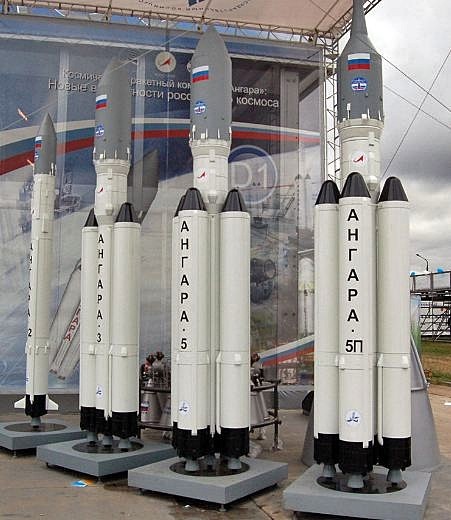By Arthur Dominic J. Villasanta , | April 06, 2017

Scale models of the Angara launch vehicle family.
Another year, another delay for the second launch of Russia's troubled Angara A5 heavy lift launch vehicle.
Angara A5 was first successfully launched on December 23, 2014 but its second launch has been delayed again and again. The second launch for the Angara A5 was to have taken place this year but has been postponed yet again -- and for another new reason -- to 2018.
Like Us on Facebook
This time, it was for a "quite trite" reason, said Andrei Kalinovsky, Director General of Khrunichev State Research and Production Space Center, the state-owned firm that developed the Angara family of launch vehicles.
"We have put it off until 2018. The reason is quite trite: the research and development efforts coincided with the transfer of production to (the Siberian city of) Omsk, and, by mutual consent with the Defense Ministry, we decided to hold additional tests," explained Kalinovsky.
"They are needed to confirm that the Omsk plant is ready from the point of view of production quality, sequence of production operations and qualification of personnel."
The second launch of Angara was officially scheduled for the end of 2016, said Russian state-controlled media. The reason given in May 2016 for the delay of the second flight scheduled for that year was due to manufacturing and testing problems experienced by Polyot Production Association, which is part of Khrunichev.
These problems delayed by three months the production of essential parts for the rocket.
Surprisingly, a source in Russia's space industry said in May 2016 that the launch would be unlikely "even in early 2017," a prediction fulfilled on April 5 by Kalinovsky's announcement and one that indicates deep-seated problems known but unsolved by Russia's space industry experts.
Angara's second flight will orbit its first commercial payload: Angosat-1, Angola's telecommunications satellite. Angola will have to wait again.
Angara is a new generation of Russian launch vehicle family consisting of a universal rocket module with oxygen-kerosene engines.
The Angara family includes the light rocket Angara 1.2 (liftoff mass 171 tons, payload 3.8 tons); the medium Angara A3 (481 tons, 1 to 14.6 tons) and the heavy Angara A5 (773 tons 3 to 24.5 tons) and Angara A7 (1,113 tons, 7.6 to 35 tons).
These rockets will be used to launch a wide variety of payloads such as satellites, manned spacecraft and inter-planetary space probes.
-
Use of Coronavirus Pandemic Drones Raises Privacy Concerns: Drones Spread Fear, Local Officials Say

-
Coronavirus Hampers The Delivery Of Lockheed Martin F-35 Stealth Fighters For 2020

-
Instagram Speeds Up Plans to Add Account Memorialization Feature Due to COVID-19 Deaths

-
NASA: Perseverance Plans to Bring 'Mars Rock' to Earth in 2031

-
600 Dead And 3,000 In The Hospital as Iranians Believed Drinking High-Concentrations of Alcohol Can Cure The Coronavirus

-
600 Dead And 3,000 In The Hospital as Iranians Believed Drinking High-Concentrations of Alcohol Can Cure The Coronavirus

-
COVID-19: Doctors, Nurses Use Virtual Reality to Learn New Skills in Treating Coronavirus Patients










